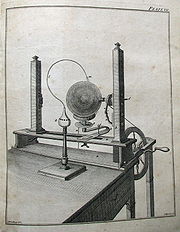
The History and Present State of Electricity
Encyclopedia

Polymath
A polymath is a person whose expertise spans a significant number of different subject areas. In less formal terms, a polymath may simply be someone who is very knowledgeable...
Joseph Priestley
Joseph Priestley
Joseph Priestley, FRS was an 18th-century English theologian, Dissenting clergyman, natural philosopher, chemist, educator, and political theorist who published over 150 works...
, is a survey of the study of electricity up until 1766 as well as a description of experiments by Priestley himself.
Priestley became interested in electricity
Electricity
Electricity is a general term encompassing a variety of phenomena resulting from the presence and flow of electric charge. These include many easily recognizable phenomena, such as lightning, static electricity, and the flow of electrical current in an electrical wire...
while he was teaching at Warrington Academy
Warrington Academy
Warrington Academy, active as a teaching establishment from 1756 to 1782, was a prominent dissenting academy, that is, a school or college set up by those who dissented from the state church in England...
. Friends introduced him to the major British experimenters in the field: John Canton
John Canton
John Canton FRS was an English physicist.Canton was born in Middle Street Stroud, Gloucestershire, the son of a weaver John Canton and Esther He had only a common education, after which he was put apprentice to a broadcloth weaver, but his leisure hours were devoted to mathematical studies, and...
, William Watson, and Benjamin Franklin
Benjamin Franklin
Dr. Benjamin Franklin was one of the Founding Fathers of the United States. A noted polymath, Franklin was a leading author, printer, political theorist, politician, postmaster, scientist, musician, inventor, satirist, civic activist, statesman, and diplomat...
. These men encouraged Priestley to perform the experiments he was writing about in his history; they believed that he could better describe the experiments if he had performed them himself. In the process of replicating others' experiments, however, Priestley became intrigued by the still unanswered questions regarding electricity and was prompted to design and undertake his own experiments.
The first half of the 700-page book is a history of the study of electricity and the second and more influential half is a description of contemporary theories about electricity and suggestions for future research. Priestley reported some of his own discoveries in the second section, such as the conductivity of charcoal
Charcoal
Charcoal is the dark grey residue consisting of carbon, and any remaining ash, obtained by removing water and other volatile constituents from animal and vegetation substances. Charcoal is usually produced by slow pyrolysis, the heating of wood or other substances in the absence of oxygen...
. This discovery overturned what he termed "one of the earliest and universally received maxims of electricity," that only water and metals could conduct electricity. Such experiments demonstrate that Priestley was interested in the relationship between chemistry and electricity from the beginning of his scientific career. In one of his more speculative moments, he "provided a mathematical quasi-demonstration of the inverse-square force law for electrical charges. It was the first respectable claim for that law, out of which came the development of a mathematical theory of static electricity."
Priestley's strength as a natural philosopher was qualitative rather than quantitative and his observation of "a current of real air" between two electrified points would later interest Michael Faraday
Michael Faraday
Michael Faraday, FRS was an English chemist and physicist who contributed to the fields of electromagnetism and electrochemistry....
and James Clerk Maxwell
James Clerk Maxwell
James Clerk Maxwell of Glenlair was a Scottish physicist and mathematician. His most prominent achievement was formulating classical electromagnetic theory. This united all previously unrelated observations, experiments and equations of electricity, magnetism and optics into a consistent theory...
as they investigated electromagnetism
Electromagnetism
Electromagnetism is one of the four fundamental interactions in nature. The other three are the strong interaction, the weak interaction and gravitation...
. Priestley's text became the standard history of electricity for over a century; Alessandro Volta
Alessandro Volta
Count Alessandro Giuseppe Antonio Anastasio Gerolamo Umberto Volta was a Lombard physicist known especially for the invention of the battery in 1800.-Early life and works:...
(who would go on to invent the battery), William Herschel
William Herschel
Sir Frederick William Herschel, KH, FRS, German: Friedrich Wilhelm Herschel was a German-born British astronomer, technical expert, and composer. Born in Hanover, Wilhelm first followed his father into the Military Band of Hanover, but emigrated to Britain at age 19...
(who discovered infrared radiation), and Henry Cavendish
Henry Cavendish
Henry Cavendish FRS was a British scientist noted for his discovery of hydrogen or what he called "inflammable air". He described the density of inflammable air, which formed water on combustion, in a 1766 paper "On Factitious Airs". Antoine Lavoisier later reproduced Cavendish's experiment and...
(who discovered hydrogen
Hydrogen
Hydrogen is the chemical element with atomic number 1. It is represented by the symbol H. With an average atomic weight of , hydrogen is the lightest and most abundant chemical element, constituting roughly 75% of the Universe's chemical elemental mass. Stars in the main sequence are mainly...
) all relied upon it. Priestley wrote a popular version of the History of Electricity for the general public titled A Familiar Introduction to the Study of Electricity (1768).
External links
- Priestley, Joseph. The History and Present State of Electricity, with original experiments. London: Printed for J. Dodsley, J. Johnson and T. Cadell, 1767. (Third edition, 1775)

